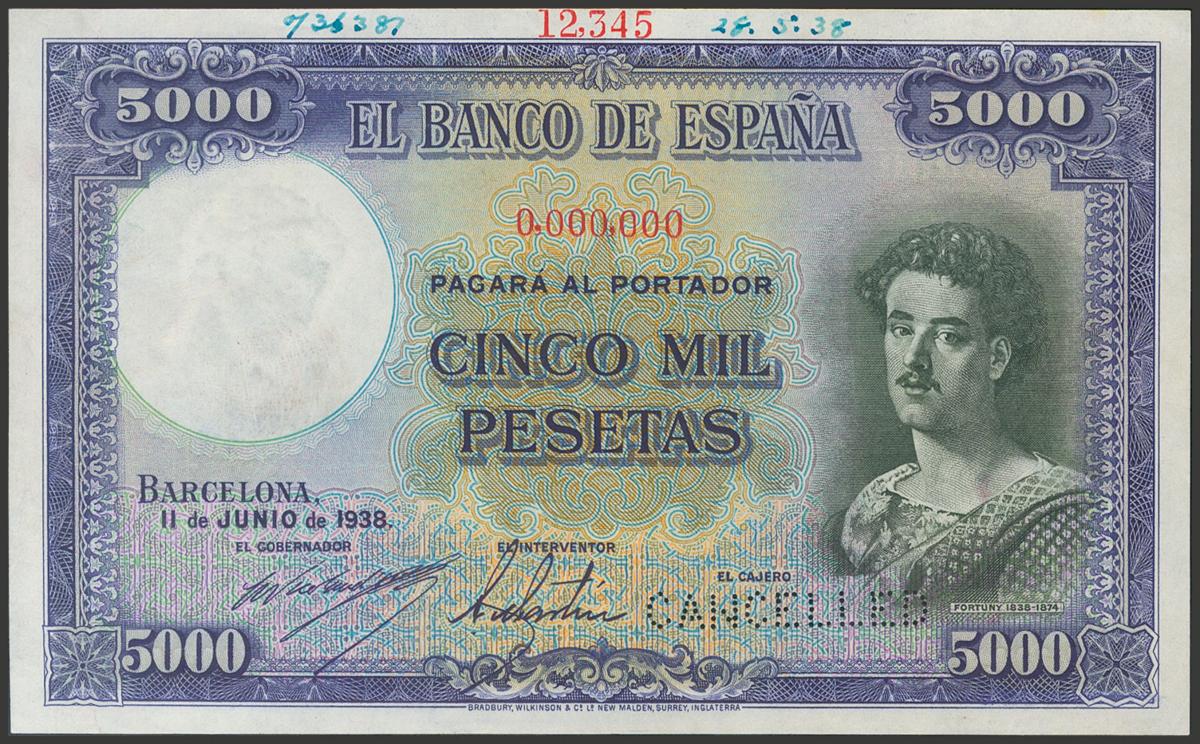2145 | Spanish Bank Notes












Automatically generated translation
 5000 pesetas. June 11, 1938. Numbering 0.000.000 and CANCELLED drilling on the space destined for the signature of the cashier, on the back proof of control 0.000.001 to 2.000.000. (Edifil 2017: NE35NPf). Extraordinarily rare and very spectacular, another copy of the same characteristics is known from the Bradbury archives, in total no more than ten copies are known and all of them in the phases prior to the final issue that were never printed, no doubt we are in front of the most iconic banknote of the twentieth century along with that of "La Dama de Elche", but the latter is not as rare as the "Fortuny". Almost Uncirculated. (For information purposes, we note that this copy from the Bradbury archive has the invisible mark of its assembly like most banknotes from the archive).
5000 pesetas. June 11, 1938. Numbering 0.000.000 and CANCELLED drilling on the space destined for the signature of the cashier, on the back proof of control 0.000.001 to 2.000.000. (Edifil 2017: NE35NPf). Extraordinarily rare and very spectacular, another copy of the same characteristics is known from the Bradbury archives, in total no more than ten copies are known and all of them in the phases prior to the final issue that were never printed, no doubt we are in front of the most iconic banknote of the twentieth century along with that of "La Dama de Elche", but the latter is not as rare as the "Fortuny". Almost Uncirculated. (For information purposes, we note that this copy from the Bradbury archive has the invisible mark of its assembly like most banknotes from the archive).
The first attempt to issue a banknote with a value above the legal limit of 1000 pesetas dates from 1938, during the Spanish Civil War, in Republican territory. The need to put high denominations into circulation was covered by the issuance of the 500 and 1000 pesetas notes of 1928, as well as the 500 pesetas of 1935 of Hernán Cortés. However, the uncontrolled Republican inflation required moving the bar to values never seen before. That is why the Bank of Spain, already transferred to Barcelona, commissioned in April 1938 the manufacture of a 5000 pesetas note from the English house Bradbury, Wilkinson and Cº, with which Spain had been working since 1906.
The obverse of this banknote shows a portrait of the brilliant orientalist-style Catalan painter, Mariano Fortuny, painted by himself around 1873, shortly before his death. The reverse of the banknote reproduces the painting “La Vicaría”, painted in 1870 by Fortuny himself and whose engraving on the banknote we owe to the British Edward T. Dawson.
This specimen of 5000 pesetas from 1938 that we show comes directly from the archive of the English house Bradbury, Wilkinson and Cº, where it served as a reference and control. Only two archival copies of this note are known from the Bradbury, Wilkinson and Cº. There are other sample copies, without numbering, with red stamp and with signatures (they do not reach half a dozen) and at least one that is, probably, an intermediate sample without stamp, without signatures and without place and date of issue, all of them with cancellation drills.
The registration tickets have handwritten annotations (on those dates in blue ink) that indicate the order number (36387) and the date of the order (May 28, 1938). Likewise, a sample of typography (12,345) is included in the upper margin, a characteristic feature of the Bradbury that it began to indicate on its archival banknotes from mid-1928. Another unique aspect of this copy that we present, and that it shares with others specimens, is the cancellation of the cashier's signature, to ensure that it could not be put into circulation. But in this case, unlike the rest of the known copies of this very rare banknote, this is done by drilling points with the legend CANCELLED. In addition, this registration ticket shows the position, color and typography of the serial numbers that the final ticket would have worn, another differentiating element from the other known samples.
Mariano Fortuny's ticket did not circulate given the dates that were handled. The order was put to the printing press in May 1938, as we can see in the annotations of this registration copy, but the proofs of selection of colors by layers are dated September 9, 1938, when the war was already decadent towards the National side. Given that Bradbury, at this time, typically took about six months to complete a design and produce the first copies, it is possible to speculate that by October or November at the latest, the English house would have been in a position to begin distributing the first packages of these bills. Failure to do so must have been due to the cancellation of the order, a particular aspect of which we still do not have enough study material.
We thank Jose Antonio Castellanos Vargas for his collaboration in the historical contextualization of this extraordinary and historical piece of the Spanish notaphilia.
Online Banknotes Auction #54
Wednesday, 28 July 2021 | 16:00
Lot 2145














